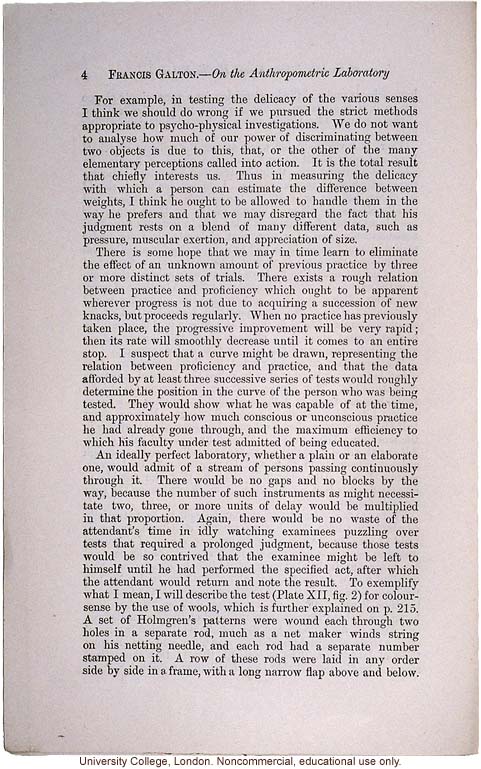4 Francis Galton. - On the Anthropometric Laboratory
For example, in testing the delicacy of the various senses I think we should do wrong if we pursued the strict methods appropriate to psycho-physical investigations. We do not want to analys how much of our power of discriminating between two objects is due to this, that, or the other of the many elementary perception called into action. It is the total result that chiefly interests us. Thus in measuring the delicacy with which a person can estimate the difference between weights, I think he ought to be allowed to handle them in the way he prefers and that we may disregard the fact that his judgment rests on a blend of many different data, such as pressure, muscular exertion, and appreciation of size.
There is some hope that we may in time learn to eliminate the effect of an unknown amount of previous practice by three or more distinct sets of trials. There exists a rough relation between practice and proficiency which ought to be apparent wherever progress is not due to acquiring a succession of new knacks, but proceeds regularly. When no practice has previously taken place, the progressive improvement will be very rapid; then its rate will smoothly decrease until it comes to an entire stop. I suspect that a curve might be drawn, representing the relation between proficiency and practice, and that the data afforded by at least three successive series of tests would roughly determine the position in the curve of the person who was being tested. They would show what he was capable of at the time, and approximately how much conscious or unconscious practice he had already gone through, and the maximum efficiency to which his faculty under test admitted of being educated.
An ideally perfect laboratory, whether a plain or elaborate one, would admit of a stream of persons passing continuously through it. There would be no gaps and no blocks by the way, because the number of such instruments as might necessitate two, three, or more units of delay would be multiplied in that proportion. Again, there would be no waste of the attendant's time in idly watching examines puzzling over tests that required a prolonged judgment, because those tests would be so contrived that the examinee might be left to himself until he had performed the specified act, after which the attendant would return and note the result. To exemplify what I mean, I will describe the test (Plate XII, fig. 2) for colour-sense by the use of wools, which is further explained on p. 215. A set of Holmgren's patterns were wound each through two holes in a separate rod, much as a net maker winds string on his netting needle, and each rod had a separate number stamped on it. A row of these rods were laid in any order side by side in a frame, with a long narrow flap above and below.
[end]


